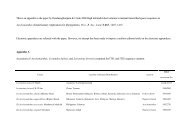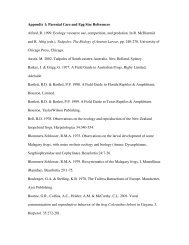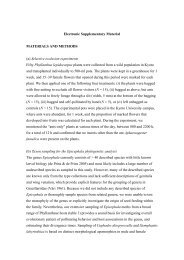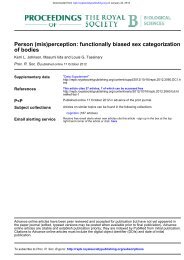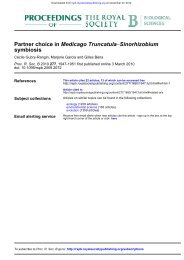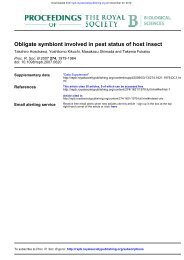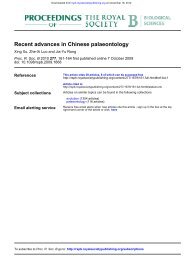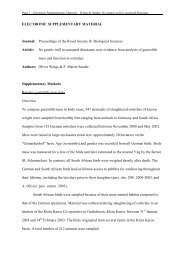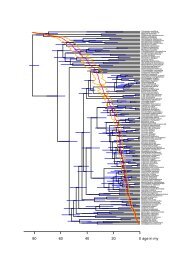On the origin of the desert locust Schistocerca gregaria (Forska˚l ...
On the origin of the desert locust Schistocerca gregaria (Forska˚l ...
On the origin of the desert locust Schistocerca gregaria (Forska˚l ...
You also want an ePaper? Increase the reach of your titles
YUMPU automatically turns print PDFs into web optimized ePapers that Google loves.
<strong>On</strong> <strong>the</strong> <strong>origin</strong> <strong>of</strong> <strong>the</strong> <strong>desert</strong> <strong>locust</strong> <strong>Schistocerca</strong><br />
<strong>gregaria</strong> (Forska˚ l) (Orthoptera: Acrididae:<br />
Cyrtacanthacridinae)<br />
Hojun Song<br />
Department <strong>of</strong> Entomology, The Ohio State University, 1315 Kinnear Road, Columbus, OH 43212, USA<br />
(song.131@osu.edu)<br />
Received 25 January 2004<br />
Accepted 25 March 2004<br />
Published online 15 June 2004<br />
The <strong>locust</strong> genus <strong>Schistocerca</strong> (Sta˚l) has a transatlantic disjunction, which has been controversial for more<br />
than a century. Among 50 species within <strong>the</strong> genus, only one species, <strong>the</strong> <strong>desert</strong> <strong>locust</strong> (S. <strong>gregaria</strong><br />
<strong>Forska˚l</strong>), occurs in <strong>the</strong> Old World, and <strong>the</strong> rest occur in <strong>the</strong> New World. Earlier taxonomists suggested<br />
that <strong>the</strong> <strong>desert</strong> <strong>locust</strong> is a migrant from America, but this view was strongly challenged when a large<br />
swarm <strong>of</strong> <strong>the</strong> <strong>desert</strong> <strong>locust</strong> successfully crossed <strong>the</strong> Atlantic Ocean from West Africa to <strong>the</strong> West Indies<br />
in 1988. The currently accepted view, supported by this incident, is that <strong>the</strong> New World species are<br />
descendants <strong>of</strong> a <strong>gregaria</strong>-like ancestor, and <strong>the</strong> <strong>desert</strong> <strong>locust</strong> would be ancestral to <strong>the</strong> rest <strong>of</strong> <strong>the</strong> genus.<br />
However, <strong>the</strong>re is surprisingly little evidence to support this view o<strong>the</strong>r than <strong>the</strong> 1988 swarm. I present<br />
<strong>the</strong> most comprehensive phylogenetic study that suggests that <strong>the</strong> <strong>desert</strong> <strong>locust</strong> <strong>origin</strong>ated from <strong>the</strong> New<br />
World, contrary to <strong>the</strong> accepted view. I also present a hypo<strong>the</strong>sis about how <strong>the</strong> ancestral <strong>Schistocerca</strong><br />
might have colonized <strong>the</strong> New World in <strong>the</strong> first place in light <strong>of</strong> phylogenetic relationships with o<strong>the</strong>r<br />
cyrtacanthacridine genera.<br />
Keywords: <strong>Schistocerca</strong> <strong>gregaria</strong>; biogeography; <strong>locust</strong> swarm; phylogeny<br />
1. INTRODUCTION<br />
<strong>Schistocerca</strong> Sta˚l is <strong>the</strong> largest and most diverse genus<br />
within <strong>the</strong> subfamily Cyrtacanthacridinae, containing ca.<br />
50 species, widely distributed throughout <strong>the</strong> New World<br />
(Dirsh 1974). The <strong>desert</strong> <strong>locust</strong>, <strong>Schistocerca</strong> <strong>gregaria</strong><br />
(<strong>Forska˚l</strong>), is <strong>the</strong> only Old World representative <strong>of</strong> <strong>the</strong><br />
genus and it is one <strong>of</strong> <strong>the</strong> most notorious insects in <strong>the</strong><br />
world. It is <strong>the</strong> biblical <strong>locust</strong> infamous for forming enormous<br />
swarms, and it annually causes severe agricultural<br />
and economic damage to African countries (Uvarov 1966,<br />
1977; Showler 1995; Pener & Yerushalmi 1998). By contrast,<br />
<strong>the</strong> New World <strong>Schistocerca</strong> species have adapted to<br />
specific ecological niches, and most <strong>of</strong> <strong>the</strong>m are sedentary.<br />
The relationship between <strong>the</strong> <strong>desert</strong> <strong>locust</strong> and <strong>the</strong> New<br />
World species has been unclear, but based on <strong>the</strong> unbalanced<br />
number <strong>of</strong> species on each continent, <strong>the</strong> geographical<br />
distribution <strong>of</strong> <strong>Schistocerca</strong> is a clear case <strong>of</strong><br />
transatlantic disjunction. How did such a disjunction<br />
arise? Because all <strong>the</strong> species occur in <strong>the</strong> New World<br />
except for <strong>the</strong> <strong>desert</strong> <strong>locust</strong>, earlier workers thought that<br />
<strong>the</strong> <strong>desert</strong> <strong>locust</strong> was a descendant <strong>of</strong> <strong>the</strong> American relatives.<br />
Two revisers <strong>of</strong> <strong>the</strong> genus, Scudder (1899) and<br />
Dirsh (1974), expressed a similar view that <strong>Schistocerca</strong><br />
<strong>origin</strong>ated in America and from <strong>the</strong>re populated <strong>the</strong> Old<br />
World after <strong>the</strong> genus diversified in <strong>the</strong> New World. In<br />
essence, <strong>the</strong>ir view requires a phylogeny that <strong>the</strong> <strong>desert</strong><br />
<strong>locust</strong> is positioned within <strong>the</strong> New World clade (figure<br />
1a). This scenario has been referred to as <strong>the</strong> New World<br />
Origin hypo<strong>the</strong>sis <strong>of</strong> <strong>the</strong> <strong>desert</strong> <strong>locust</strong>.<br />
In October 1988, <strong>the</strong>re was a dramatic incident that<br />
radically changed this view. A large swarm <strong>of</strong> S. <strong>gregaria</strong><br />
<strong>origin</strong>ating from West Africa successfully crossed <strong>the</strong><br />
Atlantic Ocean to reach <strong>the</strong> West Indies (Kevan 1989;<br />
Ritchie & Pedgley 1989). This seemingly impossible flight<br />
was later postulated to have lasted only a few days, considering<br />
<strong>the</strong> energy required to achieve <strong>the</strong> continuous<br />
flight <strong>of</strong> 5000 km (Kevan 1989). There had been records<br />
<strong>of</strong> <strong>locust</strong>s taken at sea (Howard 1917; Wal<strong>of</strong>f 1946), but<br />
this was <strong>the</strong> first publicized incident <strong>of</strong> a successful flight.<br />
Because this effectively demonstrated that a <strong>locust</strong> swarm<br />
is capable <strong>of</strong> a transatlantic flight, orthopterists now had<br />
a reasonable explanation for <strong>the</strong> disjunction. Ritchie &<br />
Pedgley (1989) and Kevan (1989) proposed an alternative<br />
view that <strong>the</strong> New World species are descendants <strong>of</strong> a<br />
‘<strong>gregaria</strong>-like’ ancestor from <strong>the</strong> Old World that crossed<br />
<strong>the</strong> Atlantic Ocean by flight. This view has been referred<br />
to as <strong>the</strong> Old World Origin hypo<strong>the</strong>sis, and it is <strong>the</strong> currently<br />
accepted view on <strong>the</strong> diversification <strong>of</strong> <strong>Schistocerca</strong>.<br />
According to this view, <strong>the</strong> <strong>desert</strong> <strong>locust</strong> would be <strong>the</strong><br />
remnant or descendant <strong>of</strong> <strong>the</strong> ancestor that gave rise to<br />
<strong>the</strong> New World <strong>Schistocerca</strong>, and it, in essence, requires a<br />
phylogeny that <strong>the</strong> <strong>desert</strong> <strong>locust</strong> is positioned basal to <strong>the</strong><br />
rest <strong>of</strong> <strong>the</strong> New World species (figure 1b). Kevan (1989)<br />
also suggested a possibility that <strong>the</strong> New World<br />
<strong>Schistocerca</strong> could have been a result <strong>of</strong> multiple crossings<br />
by <strong>the</strong> ancestral <strong>Schistocerca</strong> from <strong>the</strong> Old World. This<br />
view was later expanded by Amedegnato (1993), but did<br />
not gain a wide acceptance. According to this Multiple<br />
Crossings hypo<strong>the</strong>sis, <strong>the</strong> ancestral <strong>Schistocerca</strong> repeatedly<br />
crossed <strong>the</strong> Atlantic Ocean to give rise to several lineages<br />
in <strong>the</strong> New World. This hypo<strong>the</strong>sis inherently assumes<br />
that <strong>the</strong> <strong>desert</strong> <strong>locust</strong> is <strong>the</strong> most recent ancestral stock<br />
that gave rise to <strong>the</strong> swarming species in <strong>the</strong> New World.<br />
If this is <strong>the</strong> correct view, it will require a phylogeny that<br />
has a large and diverse clade at <strong>the</strong> base, representing<br />
older lineages by <strong>the</strong> ancestral <strong>Schistocerca</strong> and ano<strong>the</strong>r<br />
clade that has <strong>the</strong> <strong>desert</strong> <strong>locust</strong> at <strong>the</strong> base (figure 1c).<br />
This phylogeny superficially resembles that for <strong>the</strong> New<br />
World Origin hypo<strong>the</strong>sis, but it differs in <strong>the</strong> position <strong>of</strong><br />
Proc. R. Soc. Lond. B (2004) 271, 1641–1648 1641 © 2004 The Royal Society<br />
DOI 10.1098/rspb.2004.2758
1642 H. Song Origin <strong>of</strong> <strong>the</strong> <strong>desert</strong> <strong>locust</strong><br />
(a) (b)<br />
(c)<br />
S.g. S.g. S.g.<br />
Figure 1. Three contrasting hypo<strong>the</strong>ses on <strong>the</strong> <strong>origin</strong> <strong>of</strong> <strong>the</strong> <strong>desert</strong> <strong>locust</strong>. Each cladogram represents a simplified version <strong>of</strong><br />
<strong>Schistocerca</strong> phylogeny. S.g. is an abbreviation <strong>of</strong> <strong>Schistocerca</strong> <strong>gregaria</strong>. (a) Presumed phylogeny <strong>of</strong> <strong>the</strong> New World Origin<br />
hypo<strong>the</strong>sis. If <strong>the</strong> <strong>desert</strong> <strong>locust</strong> colonized <strong>the</strong> Old World after <strong>Schistocerca</strong> diversified in <strong>the</strong> New World, S. <strong>gregaria</strong> would be<br />
positioned deep among <strong>the</strong> New World clades. (b) Presumed phylogeny <strong>of</strong> <strong>the</strong> Old World Origin hypo<strong>the</strong>sis. If <strong>the</strong> New<br />
World species were descendants <strong>of</strong> a ‘<strong>gregaria</strong>-like’ ancestor, S. <strong>gregaria</strong> would be basal to <strong>the</strong> rest <strong>of</strong> <strong>the</strong> genus, reflecting its<br />
ancestry. (c) Presumed phylogeny <strong>of</strong> <strong>the</strong> Multiple Crossings hypo<strong>the</strong>sis. If <strong>the</strong> ancestral <strong>Schistocerca</strong> colonized <strong>the</strong> New World<br />
multiple times, <strong>the</strong>re would be several lineages at <strong>the</strong> base and ano<strong>the</strong>r clade with <strong>the</strong> basal S. <strong>gregaria</strong>, reflecting its ancestry.<br />
S. <strong>gregaria</strong>. The Multiple Crossings hypo<strong>the</strong>sis should be<br />
considered as a variety <strong>of</strong> <strong>the</strong> Old World Origin hypo<strong>the</strong>sis<br />
because it assumes that <strong>the</strong> Old World is <strong>the</strong> <strong>origin</strong>ating<br />
point for <strong>the</strong> ancestral <strong>Schistocerca</strong>.<br />
Although <strong>the</strong> Old World Origin hypo<strong>the</strong>sis seems to be<br />
<strong>the</strong> simplest explanation for <strong>the</strong> biogeography <strong>of</strong><br />
<strong>Schistocerca</strong>, <strong>the</strong>re is, however, surprisingly little evidence<br />
for it o<strong>the</strong>r than <strong>the</strong> 1988 swarm. If <strong>the</strong> ancestral <strong>desert</strong><br />
<strong>locust</strong> gave rise to numerous New World species, why has<br />
<strong>the</strong>re been no diversification in <strong>the</strong> Old World?<br />
<strong>Schistocerca</strong> <strong>gregaria</strong> is morphologically similar enough to<br />
once be included as a subspecies <strong>of</strong> New World<br />
S. americana (Drury) (Dirsh 1974), and several hybridization<br />
studies suggested a close relationship between <strong>the</strong><br />
<strong>desert</strong> <strong>locust</strong> and <strong>the</strong> New World swarming species<br />
(Harvey 1979; Jago et al. 1979). However, <strong>the</strong> Old World<br />
Origin hypo<strong>the</strong>sis assumes that <strong>the</strong> <strong>desert</strong> <strong>locust</strong> has not<br />
evolved much while <strong>the</strong> rest <strong>of</strong> <strong>the</strong> genus greatly diversified,<br />
which is a very curious assumption. Fur<strong>the</strong>rmore,<br />
Cyrtacanthacridinae has only two New World representatives,<br />
<strong>Schistocerca</strong> and <strong>the</strong> Galapagos endemic Halmenus<br />
Scudder, which have been suggested to be closely related<br />
(Dirsh 1969, 1974). The Old World Origin hypo<strong>the</strong>sis<br />
does not account for Halmenus (Chapman et al. 2000).<br />
I conducted a cladistic analysis to test <strong>the</strong> hypo<strong>the</strong>ses<br />
<strong>of</strong> <strong>origin</strong>. Specifically, I attempt to address three questions.<br />
(i) What is <strong>the</strong> position <strong>of</strong> S. <strong>gregaria</strong> within <strong>the</strong><br />
<strong>Schistocerca</strong> clade? (ii) What is <strong>the</strong> relationship between<br />
<strong>Schistocerca</strong> and Halmenus? (iii) What is <strong>the</strong> relationship<br />
between <strong>Schistocerca</strong> and <strong>the</strong> Old World cyrtacanthacridine<br />
genera? Based on <strong>the</strong> present findings, I propose a<br />
novel view on <strong>the</strong> <strong>origin</strong> <strong>of</strong> <strong>the</strong> <strong>desert</strong> <strong>locust</strong> and <strong>the</strong> biogeography<br />
<strong>of</strong> <strong>Schistocerca</strong>. Also, I discuss <strong>the</strong> potential<br />
taxonomic implications resulting from <strong>the</strong> current phylogeny.<br />
2. MATERIAL AND METHODS<br />
The parsimony analysis was performed using 33 <strong>Schistocerca</strong><br />
species and 15 cyrtacanthacridine outgroup species (see electronic<br />
Appendix A). <strong>Schistocerca</strong> is a taxonomically problematic<br />
group, and it is currently being revised (H. Song, unpublished<br />
data). Because S. nitens nitens (Thunberg) may consist <strong>of</strong> multiple<br />
species, I designated an alphabetical letter to each morphologically<br />
distinct geographical form.<br />
Proc. R. Soc. Lond. B (2004)<br />
A total <strong>of</strong> 57 characters with 148 character states were examined<br />
(see electronic Appendix B). Characters were chosen<br />
through a comprehensive study <strong>of</strong> both external and internal<br />
morphology. Except for <strong>the</strong> few cases where specimens were limited,<br />
multiple specimens from various localities were examined<br />
and compared for each species. <strong>On</strong>ly invariable characters were<br />
used. Non-applicable characters were coded as ‘’. All characters<br />
were run equally weighted with one character being additive<br />
and 56 non-additive (see electronic Appendix C). The additive<br />
character was <strong>the</strong> shape <strong>of</strong> <strong>the</strong> male cercus, and <strong>the</strong> hypo<strong>the</strong>sis<br />
<strong>of</strong> <strong>the</strong> character transformation was made before <strong>the</strong> analysis.<br />
The Parsimony Ratchet implemented in NONA (Golob<strong>of</strong>f<br />
1995), was run within WinClada (Nixon 2002). Five repeated<br />
runs <strong>of</strong> 100 iterations <strong>of</strong> <strong>the</strong> ratchet were performed with one<br />
tree ‘hold’ and 10–18% <strong>of</strong> characters sampled. The single<br />
resulting tree was saved and o<strong>the</strong>r most-parsimonious trees were<br />
searched using ‘max ∗ ’ command in NONA. Ornithacris turbida<br />
(Walker) was used to root <strong>the</strong> tree.<br />
3. RESULTS<br />
The parsimony ratchet was used with various percentages<br />
<strong>of</strong> characters and consistently yielded a tree <strong>of</strong> 230<br />
steps. The analysis resulted in 40 most-parsimonious trees<br />
(tree length <strong>of</strong> 230 steps, consistency index (CI) = 0.39,<br />
retention index (RI) = 0.77). A strict consensus <strong>of</strong> 40<br />
most-parsimonious trees collapsed seven nodes mostly<br />
among <strong>the</strong> outgroups and produced a consensus tree <strong>of</strong><br />
245 steps (CI = 0.37, RI = 0.74; figure 2).<br />
The monophyly <strong>of</strong> <strong>Schistocerca</strong> is supported by two synapomorphies:<br />
bilobate male subgenital plate and quadrate<br />
male cercus. The ingroup clade is highly resolved although<br />
<strong>the</strong>re are some unresolved relationships among <strong>the</strong> outgroup<br />
taxa. The Bremer support value for <strong>the</strong> ingroup is<br />
low, as is typical in morphological analyses; however, <strong>the</strong><br />
retention index is high, indicating that <strong>the</strong> homoplasious<br />
characters are useful in defining <strong>the</strong> ingroup. For example,<br />
<strong>the</strong> length <strong>of</strong> tegmina is a homoplasious character in terms<br />
<strong>of</strong> <strong>the</strong> entire phylogeny, but is a synapomorphy within<br />
<strong>Schistocerca</strong>.<br />
(a) Relationships within <strong>Schistocerca</strong><br />
<strong>Schistocerca</strong> is basally divided into two clades (figure 2).<br />
The smaller clade (figure 2a) included 11 species grouped<br />
by a slightly constricted pronotum. Of <strong>the</strong>se, S. <strong>gregaria</strong>,
1<br />
1<br />
3<br />
>5<br />
2<br />
1<br />
1<br />
1<br />
1<br />
1<br />
1<br />
1<br />
1<br />
1<br />
1<br />
1<br />
1<br />
1<br />
1<br />
1<br />
1<br />
3<br />
1<br />
1<br />
1<br />
2<br />
1<br />
2<br />
1<br />
1<br />
1<br />
1<br />
1<br />
Origin <strong>of</strong> <strong>the</strong> <strong>desert</strong> <strong>locust</strong> H. Song 1643<br />
Ornithacris turbida<br />
Cyrtacanthacris tatarica<br />
Cyrtacanthacris aeruginosa<br />
Acanthacris elgonensis<br />
Acanthacris ruficornis<br />
Chondracris rosea<br />
Pachyacris vinosa<br />
Melicodes tenebrosa<br />
Anacridium aegyptium<br />
Valanga nigricornis<br />
Valanga maculicollis<br />
Austracris guttulosa<br />
Patanga japonica<br />
Patanga succincta<br />
Halmenus robustus<br />
†<br />
S. serialis cubense<br />
S. melanocera<br />
S. literosa<br />
S. serialis serialis<br />
†<br />
S. americana<br />
†<br />
S. piceifrons<br />
†<br />
S. <strong>gregaria</strong><br />
S. centralis<br />
S. pallens<br />
S. cancellata<br />
S. subspurcata<br />
†<br />
S. interrita<br />
S. quisqueya<br />
S. beckeri<br />
S. nitens nitens A<br />
S. diversipes<br />
S. braziliensis<br />
S. flav<strong>of</strong>asciata<br />
*<br />
S. nitens nitens B<br />
*<br />
S. nitens nitens C<br />
S. separata *<br />
S. nitens carribeana<br />
S. damnifica<br />
S. nitens nitens D *<br />
S. ceratiola<br />
S. new sp.<br />
S. lineata +<br />
S. shoshone +<br />
S. rubiginosa +<br />
+<br />
†<br />
S. alutacea +<br />
S. camerata<br />
+<br />
S. obscura +<br />
S. albolineata<br />
Figure 2. Strict consensus <strong>of</strong> 40 most-parsimonious trees (245 steps, CI = 0.37, RI = 0.74) with Bremer support values above<br />
<strong>the</strong> nodes. <strong>Schistocerca</strong> is a monophyletic group, shown by a light-grey rectangle. <strong>Schistocerca</strong> <strong>gregaria</strong> is positioned well within<br />
<strong>the</strong> ingroup, shown by a dark-grey rectangle. (a) Mobile clade that includes all swarming <strong>locust</strong> species and o<strong>the</strong>r species with<br />
long wings. (b) Sedentary clade that includes non-swarming species. Taxonomically problematic species in Dirsh’s (1974)<br />
revision are indicated by a dagger for S. americana sensu Dirsh, an asterisk for S. nitens sensu Dirsh, and a double dagger for<br />
S. alutacea sensu Dirsh.<br />
Proc. R. Soc. Lond. B (2004)<br />
+<br />
*<br />
†<br />
*<br />
mobile clade sedentary clade<br />
(a)<br />
(b)
1644 H. Song Origin <strong>of</strong> <strong>the</strong> <strong>desert</strong> <strong>locust</strong><br />
S. piceifrons (Walker) and S. cancellata (Serville) are known<br />
to swarm, but <strong>the</strong>y do not form a monophyletic group.<br />
Two Galapagos endemic species, S. melanocera (Sta˚l) and<br />
S. literosa (Walker), form a monophyletic clade by having<br />
male cerci that have <strong>the</strong> upper margin sharply protruding.<br />
Its position among o<strong>the</strong>r species is unresolved but generally<br />
basal in <strong>the</strong> clade. <strong>Schistocerca</strong> serialis cubense<br />
(Saussure) is not sister to <strong>the</strong> nominal subspecies S. serialis<br />
serialis (Thunberg). <strong>Schistocerca</strong> <strong>gregaria</strong> is positioned<br />
comfortably and unambiguously within <strong>the</strong> New World<br />
clade. The larger clade (figure 2b) is grouped by having a<br />
curved outer margin <strong>of</strong> tegmina and a moderately raised<br />
median carina <strong>of</strong> pronotum, and it includes <strong>the</strong> rest <strong>of</strong> <strong>the</strong><br />
genus, all <strong>of</strong> which are sedentary. <strong>Schistocerca</strong> nitens sensu<br />
Dirsh is paraphyletic, indicating that his taxonomic concept<br />
is problematic ( ∗ in figure 2). The same is true for<br />
S. alutacea sensu Dirsh (‡ in figure 2) and S. americana<br />
sensu Dirsh († in figure 2).<br />
(b) Relationships among cyrtacanthacridine<br />
genera<br />
<strong>Schistocerca</strong> is sister to <strong>the</strong> Galapagos endemic<br />
Halmenus, and this relationship is strongly supported by<br />
several synapomorphies, mostly <strong>of</strong> <strong>the</strong> male genitalia.<br />
Halmenus differs from <strong>Schistocerca</strong> by having highly<br />
reduced wings and a short conical male subgenital plate.<br />
The shape <strong>of</strong> <strong>the</strong> male subgenital plate in Cyrtacanthacridinae<br />
varies considerably, but most Old World genera<br />
have a pointed conical subgenital plate. <strong>Schistocerca</strong> and<br />
Halmenus are sister to <strong>the</strong> Australasian clade formed by<br />
Austracris guttulosa (Walker), Patanga succincta<br />
(Johannson) and P. japonica (Bolivar). Indo-Malaysian<br />
Valanga Uvarov is basal to <strong>the</strong> Australasian and New<br />
World taxa, but <strong>the</strong> monophyly <strong>of</strong> Valanga was not supported.<br />
The relationships among Chondracris Uvarov,<br />
Pachyacris Uvarov, Melicodes Uvarov, Anacridium Uvarov<br />
are largely unresolved. Basally, <strong>the</strong> African genera<br />
Cyrtacanthacris Walker and Acanthacris Uvarov form a<br />
monophyletic clade by having only six hind tibial spines<br />
and a twisted valve <strong>of</strong> cingulum, and are sister to <strong>the</strong> rest<br />
<strong>of</strong> <strong>the</strong> species.<br />
4. DISCUSSION<br />
The purpose <strong>of</strong> this study was to test <strong>the</strong> previous<br />
hypo<strong>the</strong>ses about <strong>the</strong> transatlantic disjunction <strong>of</strong> <strong>Schistocerca</strong><br />
(figure 1). The phylogeny places <strong>the</strong> <strong>desert</strong> <strong>locust</strong> within<br />
<strong>the</strong> New World clade (figure 2). Its position is unambiguous<br />
and robust because it would take at least three steps<br />
to pull S. <strong>gregaria</strong> out <strong>of</strong> <strong>the</strong> New World clade. In o<strong>the</strong>r<br />
words, <strong>the</strong> current phylogeny strongly favours <strong>the</strong> New<br />
World Origin hypo<strong>the</strong>sis (figure 1a) ra<strong>the</strong>r than <strong>the</strong><br />
accepted view <strong>of</strong> <strong>the</strong> Old World <strong>origin</strong> <strong>of</strong> <strong>the</strong> <strong>desert</strong> <strong>locust</strong><br />
(figure 1b). It is also not consistent with <strong>the</strong> phylogeny<br />
proposed by <strong>the</strong> Multiple Crossings hypo<strong>the</strong>sis (figure 1c).<br />
Instead <strong>of</strong> <strong>the</strong> <strong>desert</strong> <strong>locust</strong> being basal to <strong>the</strong> closely<br />
related species, S. <strong>gregaria</strong> is unambiguously placed within<br />
<strong>the</strong> smaller clade. This indicates that <strong>the</strong> ancestral <strong>desert</strong><br />
<strong>locust</strong> did not give rise to <strong>the</strong> species in <strong>the</strong> smaller clade.<br />
<strong>Schistocerca</strong> serialis is morphologically very similar to <strong>the</strong><br />
species in <strong>the</strong> Americana Group, but it is basal to <strong>the</strong> rest<br />
according to <strong>the</strong> current phylogeny. This would suggest<br />
that S. serialis went through an impressive morphological<br />
Proc. R. Soc. Lond. B (2004)<br />
convergence to resemble <strong>the</strong> rest <strong>of</strong> <strong>the</strong> clade, if <strong>the</strong> Multiple<br />
Crossings hypo<strong>the</strong>sis is to be forced. This, <strong>of</strong> course,<br />
requires too many ad hoc explanations that are not testable.<br />
The most parsimonious explanation from <strong>the</strong> current<br />
phylogeny would be that <strong>the</strong> ancestral <strong>desert</strong> <strong>locust</strong><br />
colonized <strong>the</strong> Old World from <strong>the</strong> New World. How could<br />
this colonization have happened?<br />
Two possible colonization routes have been suggested.<br />
The first is by <strong>the</strong> Bering land bridge. Dirsh (1974) suggested<br />
that <strong>the</strong> ancestral <strong>desert</strong> <strong>locust</strong> might have migrated<br />
from America through Eurasia and Europe and finally<br />
reached Africa. However, this route is unlikely because<br />
<strong>the</strong>re is no species closely related to <strong>the</strong> <strong>desert</strong> <strong>locust</strong> in<br />
nor<strong>the</strong>rn North America or eastern Russia. If <strong>the</strong> colonization<br />
route was overland, it is reasonable to expect that<br />
<strong>the</strong>re could be some relic populations. Of course, <strong>the</strong><br />
absence <strong>of</strong> a population is insufficient evidence for<br />
rejecting a hypo<strong>the</strong>sis, but <strong>the</strong>re is an alternative route that<br />
is more parsimonious. This second route is a direct transatlantic<br />
flight from America to West Africa. The incident<br />
in 1988 demonstrates that a <strong>locust</strong> swarm is capable <strong>of</strong><br />
a long-distance flight with favourable conditions (Kevan<br />
1989). However, <strong>the</strong> prevailing wind direction between<br />
two continents does not favour <strong>the</strong> eastward flight route<br />
from America to Africa. The prevailing wind direction is<br />
westward from Africa to America owing to both Nor<strong>the</strong>rn<br />
and Sou<strong>the</strong>rn Trade Currents (Thurman 1975). The<br />
1988 swarm took advantage <strong>of</strong> <strong>the</strong> Nor<strong>the</strong>rn Trade Current.<br />
However, <strong>the</strong>re is indeed an eastward wind current,<br />
<strong>the</strong> Equatorial Countercurrent, which blows eastwards<br />
along <strong>the</strong> equator. Therefore, it is possible that <strong>the</strong> ancestral<br />
<strong>desert</strong> <strong>locust</strong> might have taken advantage <strong>of</strong> this eastward<br />
current and colonized Africa. In o<strong>the</strong>r words, <strong>the</strong><br />
New World Origin hypo<strong>the</strong>sis has just as valid meteorological<br />
support as does <strong>the</strong> Old World Origin hypo<strong>the</strong>sis.<br />
This indicates that <strong>the</strong> Old World Origin hypo<strong>the</strong>sis cannot<br />
be preferred on <strong>the</strong> direction <strong>of</strong> <strong>the</strong> prevailing winds<br />
alone. It is impossible to directly demonstrate <strong>the</strong> eastward<br />
colonization, but <strong>the</strong> historical pattern deduced from <strong>the</strong><br />
phylogeny clearly points to <strong>the</strong> New World Origin hypo<strong>the</strong>sis.<br />
Yet, a question remains. How did <strong>the</strong> ancestral<br />
<strong>Schistocerca</strong> reach <strong>the</strong> New World in <strong>the</strong> first place? This<br />
is an appropriate question because <strong>of</strong> <strong>the</strong> distribution <strong>of</strong><br />
<strong>the</strong> subfamily Cyrtacanthacridinae. This subfamily contains<br />
approximately 35 genera, <strong>of</strong> which only two occur in<br />
<strong>the</strong> New World: <strong>Schistocerca</strong> and <strong>the</strong> Galapagos endemic<br />
Halmenus. The rest <strong>of</strong> <strong>the</strong> genera are distributed in <strong>the</strong><br />
Old World, mainly in Africa (Uvarov 1923). Indeed, this<br />
is one <strong>of</strong> <strong>the</strong> reasons why <strong>the</strong> Old World Origin hypo<strong>the</strong>sis<br />
was favoured initially. Earlier workers thought that <strong>the</strong><br />
centre <strong>of</strong> <strong>origin</strong> for Cyrtacanthacridinae was Africa, and<br />
<strong>Schistocerca</strong> must have come from Africa (Vickery & Kevan<br />
1983; Vickery 1989). Although <strong>the</strong> present study focused<br />
on <strong>the</strong> ingroup relationships, it included enough outgroup<br />
species to infer <strong>the</strong> biogeographic pattern <strong>of</strong> <strong>the</strong> subfamily.<br />
The phylogeny (figure 3) suggests that <strong>the</strong> basal genera<br />
are from Africa, and <strong>the</strong>re seems to be an eastward progression<br />
from Africa to Asia to <strong>the</strong> Indo-Pacific and Australia,<br />
and to <strong>the</strong> New World. <strong>Schistocerca</strong> and Halmenus<br />
form a strong monophyletic clade, indicating that <strong>the</strong><br />
common ancestor <strong>of</strong> <strong>the</strong>se two genera colonized <strong>the</strong> New<br />
World. This clade is, in turn, sister to <strong>the</strong> Australasian
transpacific<br />
disjunction<br />
colonization <strong>of</strong><br />
<strong>the</strong> New World<br />
Ornithacris<br />
Cyrtacanthacris<br />
Acanthacris<br />
Anacridium<br />
Chondracris<br />
Pachyacris<br />
Melicodes<br />
Valanga<br />
Austracris<br />
Patanga<br />
Halmenus<br />
<strong>Schistocerca</strong><br />
Africa<br />
Africa, Asia<br />
Africa<br />
Africa<br />
Asia<br />
Asia<br />
Asia<br />
Indo-Pacific<br />
Australia<br />
Asia<br />
Galapagos<br />
America<br />
Figure 3. Simplified cladogram <strong>of</strong> <strong>the</strong> outgroup relationships.<br />
Normal geographical distribution is placed next to each<br />
terminal showing a biogeographic trend. Two New World<br />
genera, <strong>Schistocerca</strong> and Halmenus, form a monophyletic<br />
group, indicating that a common ancestor <strong>of</strong> both colonized<br />
<strong>the</strong> New World. This clade is, in turn, sister to <strong>the</strong><br />
Australasian clade, suggesting a transpacific disjunction.<br />
clade <strong>of</strong> Austracris and Patanga. In o<strong>the</strong>r words, <strong>the</strong>re is a<br />
transpacific disjunction within <strong>the</strong> subfamily. In<br />
explaining this kind <strong>of</strong> disjunction, it is tempting to invoke<br />
an ancient vicariance event such as <strong>the</strong> Gondwanaland<br />
distribution (Vickery 1989). However, <strong>the</strong>re is an abundance<br />
<strong>of</strong> fossil evidence suggesting that <strong>the</strong> modern grasshoppers<br />
evolved during <strong>the</strong> Tertiary (Zeuner 1941,<br />
1942a,b,c). Although <strong>the</strong> order Orthoptera is known from<br />
<strong>the</strong> Carboniferous, <strong>the</strong> family Acrididae evolved relatively<br />
recently, and all <strong>the</strong> known fossils are from <strong>the</strong> Oligocene<br />
and Miocene (Zeuner 1941; Lewis 1974, 1976). Cyrtacanthacridinae<br />
perhaps evolved even later. The exact time<br />
is unknown, but by this time, all <strong>the</strong> continents were<br />
already separated by <strong>the</strong> oceanic barriers, and nearing<br />
modern positions. Therefore, invoking <strong>the</strong> vicariant<br />
Gondwanaland distribution would be incongruent with<br />
<strong>the</strong> fossil evidence, and dispersal events need to be<br />
invoked. Although <strong>the</strong>re is no reliable test to determine if<br />
<strong>the</strong> dispersal is responsible for <strong>the</strong> current biogeographic<br />
pattern, I argue that <strong>the</strong> dispersal could have been <strong>the</strong> sole<br />
mechanism for <strong>the</strong> subfamily. Species in Cyrtacanthacridinae<br />
are known for a strong flight capacity (Uvarov 1923;<br />
Dirsh & Uvarov 1953; Willemse 1957; Mungai 1987a,b,<br />
1992). They are usually large and possess long forewings.<br />
Many <strong>of</strong> <strong>the</strong>m are capable <strong>of</strong> forming a large swarm that<br />
can migrate a long distance. Therefore, it is possible to<br />
propose that <strong>the</strong> genera in Asia, <strong>the</strong> Indo-Pacific and Australia<br />
are <strong>the</strong> result <strong>of</strong> a direct eastward colonization from<br />
Africa with a single transpacific migration from Australasian<br />
regions to America. This idea is consistent with <strong>the</strong><br />
transpacific disjunction in many hemipterans and plants,<br />
and dispersal has been invoked as an explanation for <strong>the</strong>m<br />
(Schuh & Stonedahl 1986).<br />
Present analysis suggests a sister relationship between<br />
<strong>Schistocerca</strong> and Halmenus. Galapagos endemic Halmenus<br />
is a brachypterous genus containing only four species, and<br />
<strong>the</strong> loss <strong>of</strong> wings has been attributed to <strong>the</strong> rapid island<br />
brachypterism (Dirsh 1969; Amedegnato 1993). However,<br />
Proc. R. Soc. Lond. B (2004)<br />
Origin <strong>of</strong> <strong>the</strong> <strong>desert</strong> <strong>locust</strong> H. Song 1645<br />
<strong>the</strong> phallic structures <strong>of</strong> Halmenus are virtually identical to<br />
<strong>Schistocerca</strong>, suggesting that <strong>the</strong> divergence between two<br />
genera could have been very recent (Dirsh 1974). The<br />
ancestral Halmenus must have colonized <strong>the</strong> Galapagos<br />
Islands after <strong>the</strong> islands emerged, which would make<br />
Halmenus certainly less than 5 Myr old (Steadman & Ray<br />
1982). According to <strong>the</strong> cladistic <strong>the</strong>ory, sister taxa are <strong>of</strong><br />
<strong>the</strong> same age by definition, and <strong>the</strong> current phylogeny<br />
would <strong>the</strong>n suggest that <strong>Schistocerca</strong> is less than 5 Myr old.<br />
If this is true, <strong>the</strong> unbalanced dichotomy in <strong>the</strong> number<br />
<strong>of</strong> species between two genera can be attributed only to<br />
<strong>the</strong> extremely rapid diversification rate in <strong>Schistocerca</strong>.<br />
This would indicate a very high rate <strong>of</strong> speciation on <strong>the</strong><br />
mainland and not on <strong>the</strong> islands, contrary to general proposals<br />
for <strong>the</strong> Galapagos Islands. However, if an extinct<br />
lineage that gave rise to Halmenus can be invoked, it<br />
becomes possible that <strong>the</strong> age <strong>of</strong> <strong>Schistocerca</strong> may be<br />
much older.<br />
The phylogeny <strong>of</strong> <strong>Schistocerca</strong> reveals several interesting<br />
points about diversification <strong>of</strong> <strong>the</strong> genus. It suggests that<br />
<strong>the</strong> <strong>desert</strong> <strong>locust</strong> belongs to a smaller clade (figure 2a) that<br />
includes two Galapagos endemic species, all three swarming<br />
species toge<strong>the</strong>r with six non-swarming species, which<br />
can be characterized by long transparent forewings and a<br />
slender body form. All 11 species within this clade are<br />
highly mobile and strong fliers, and thus <strong>the</strong> name ‘mobile<br />
clade’ seems to be suitable. Two Galapagos endemic species,<br />
S. melanocera and S. literosa, form a monophyletic<br />
group, which indicates that <strong>the</strong> common ancestor <strong>of</strong> <strong>the</strong>se<br />
two colonized <strong>the</strong> island and diversified. Although <strong>the</strong><br />
relationship is ambiguous, this Galapagos clade can certainly<br />
be basal to <strong>the</strong> rest <strong>of</strong> <strong>the</strong> mobile clade. This in turn<br />
suggests that <strong>the</strong> ancestor <strong>of</strong> <strong>the</strong> mobile clade must have<br />
possessed a strong flight capacity, which can explain why<br />
all <strong>the</strong> species within <strong>the</strong> mobile clade are strong fliers.<br />
Three swarming <strong>Schistocerca</strong> species are S. piceifrons<br />
(Central American <strong>locust</strong>), S. cancellata (South American<br />
<strong>locust</strong>) and S. <strong>gregaria</strong> (<strong>desert</strong> <strong>locust</strong>), which are all closely<br />
related within <strong>the</strong> mobile clade. The present phylogeny<br />
suggests that <strong>the</strong>se three species do not form a monophyletic<br />
group, which indicates that <strong>the</strong> swarming behaviour<br />
has evolved multiple times even within <strong>Schistocerca</strong>. This<br />
result is congruent with experimental studies, which suggested<br />
that <strong>the</strong> swarming S. cancellata was closely related<br />
to non-swarming S. pallens (Harvey 1979; Jago et al.<br />
1979). Swarming behaviour is, however, a complex composite<br />
character, and it might be inadequate to simply<br />
state that it evolved multiple times. To study <strong>the</strong> evolution<br />
<strong>of</strong> swarming behaviour, it is important to dissect and compare<br />
<strong>the</strong> behaviour into small components such as nymphal<br />
band formation, cohesive flight and response to<br />
density. It is also crucial to study <strong>the</strong> role <strong>of</strong> environment.<br />
Perhaps one reason for swarming could be that <strong>locust</strong>s<br />
happen to exist in environments that allow for a rapid<br />
population increase, such as <strong>desert</strong>s. However, different<br />
species seem to have different genetic variations for <strong>the</strong><br />
swarming behaviour. For example, S. piceifrons and<br />
S. pallens are <strong>of</strong>ten sympatric in Mexico, but only<br />
S. piceifrons swarms despite <strong>the</strong> close phylogenetic<br />
relationship (Harvey 1983). However, <strong>the</strong> fact that all<br />
three swarming species belong to <strong>the</strong> same clade, although<br />
not monophyletic, suggests that <strong>the</strong> species within <strong>the</strong><br />
mobile clade already possessed some propensity for
1646 H. Song Origin <strong>of</strong> <strong>the</strong> <strong>desert</strong> <strong>locust</strong><br />
2(?)<br />
Figure 4. Novel hypo<strong>the</strong>sis on <strong>the</strong> <strong>origin</strong> <strong>of</strong> <strong>the</strong> <strong>desert</strong> <strong>locust</strong> based on current phylogeny. (1) Ancestral cyrtacanthacridines<br />
colonized eastwards from Africa to India, Asia, <strong>the</strong> Indo-Pacific and Australia, giving rise to several genera. (2) Possible<br />
transpacific colonization <strong>of</strong> <strong>the</strong> New World by <strong>the</strong> common ancestor <strong>of</strong> <strong>Schistocerca</strong> and Halmenus. (3) Ancestral Halmenus<br />
colonized <strong>the</strong> Galapagos Islands after <strong>the</strong> islands emerged. The Galapagos Islands were later colonized once more by <strong>the</strong><br />
common ancestor <strong>of</strong> S. melanocera and S. literosa. (4) Ancestral <strong>desert</strong> <strong>locust</strong> colonized Africa from South America possibly<br />
with a favourable wind condition along <strong>the</strong> Equatorial Countercurrent.<br />
swarming. Perhaps <strong>the</strong> reason <strong>the</strong> <strong>desert</strong> <strong>locust</strong> is so problematic<br />
is because its ancestors already possessed this propensity.<br />
The larger clade (figure 2b) contains mostly sedentary<br />
species. Sedentary <strong>Schistocerca</strong> species differ from <strong>the</strong><br />
mobile species by having long antennae and shorter wings,<br />
and a robust body form (Hubbell 1960; Song 2004).<br />
Species in this ‘sedentary clade’ are ecologically arboreal<br />
and strong fliers, but <strong>the</strong>y never form a swarm. Occasionally,<br />
aggregation behaviour has been observed in some<br />
species (Chapman et al. 1995), but <strong>the</strong>y do not have <strong>the</strong><br />
characteristic swarming behaviours such as cohesive flight<br />
or nymphal band formation. Interestingly, however, a<br />
species in <strong>the</strong> sedentary clade was recently found to<br />
possess a character, density-dependent polyphenism,<br />
important in <strong>the</strong> swarm formation <strong>of</strong> <strong>the</strong> <strong>desert</strong> <strong>locust</strong><br />
(Sword 1999, 2002). Sword (1999) discovered that <strong>the</strong><br />
nymphs <strong>of</strong> S. lineata in Texas change colour when reared<br />
in crowded conditions. The colour change was more<br />
intense in <strong>the</strong> population that primarily fed on toxic<br />
plants, suggesting that <strong>the</strong> aposematism can be mediated<br />
by <strong>the</strong> density and host preference. It is, however, not<br />
clear how widespread this phenomenon is within<br />
<strong>Schistocerca</strong>. Species in <strong>the</strong> Alutacea Group, to which S.<br />
lineata belongs, can certainly have this character because<br />
<strong>of</strong> a close relationship (Song 2004). By contrast, Rowell &<br />
Cannis (1971) found that S. nitens does not respond to<br />
<strong>the</strong> rearing density. Therefore, it is likely that <strong>the</strong> densitydependent<br />
polyphenism has evolved multiple times<br />
within <strong>Schistocerca</strong>.<br />
The differences between <strong>the</strong> mobile and <strong>the</strong> sedentary<br />
clades can perhaps be explained in an evolutionary framework.<br />
When <strong>the</strong> ancestral <strong>Schistocerca</strong> colonized <strong>the</strong> New<br />
World, it gave rise to two lineages. The present study suggests<br />
that this ancestor must have possessed an enormous<br />
flight capacity for it to cross <strong>the</strong> Pacific. <strong>On</strong>e lineage<br />
retained many ancestral characteristics and gave rise to <strong>the</strong><br />
mobile clade. With <strong>the</strong> symplesiomorphic characters that<br />
were already adapted to long-distance migration, several<br />
Proc. R. Soc. Lond. B (2004)<br />
3<br />
4<br />
1<br />
swarming species could have evolved. The o<strong>the</strong>r lineage<br />
quickly adapted to <strong>the</strong> different ecological niches and<br />
became sedentary. Although certain plesiomorphic<br />
characters such as <strong>the</strong> density-dependent polyphenism<br />
have been retained, <strong>the</strong> species in <strong>the</strong> sedentary clade have<br />
now completely lost <strong>the</strong> swarming capacity. <strong>Schistocerca</strong><br />
ceratiola is a good example <strong>of</strong> <strong>the</strong> extreme adaptation to a<br />
specific environment. This nocturnal species is endemic to<br />
central Florida, and feeds exclusively on Florida rosemary,<br />
Ceratiola ericoides Michaux (Hubbell & Walker 1928). Its<br />
eyes have been enlarged to cope with <strong>the</strong> nocturnal habit,<br />
and <strong>the</strong> body has become very slender, perhaps to deal<br />
with life on rosemary. O<strong>the</strong>r sedentary species have also<br />
adapted to various habitats and host plants, suggesting<br />
that <strong>the</strong> sedentary clade <strong>of</strong> <strong>Schistocerca</strong> in particular seems<br />
to have experienced some sort <strong>of</strong> adaptive radiation.<br />
The phylogeny reveals several taxonomic problems in<br />
<strong>Schistocerca</strong>. The taxonomy <strong>of</strong> <strong>the</strong> genus is poorly understood,<br />
despite a revision by Dirsh (1974). His revision,<br />
which resulted in numerous synonymies, is problematic<br />
because Dirsh used an unjustified morphometric technique,<br />
a method <strong>origin</strong>ally devised to differentiate between<br />
phases <strong>of</strong> a swarming <strong>locust</strong>. In justifying <strong>the</strong> synonymy,<br />
Dirsh reasoned that any taxa that share similar morphometric<br />
ratios should be considered as one species. By<br />
doing so, he synonymized 11 names under S. americana,<br />
seven names under S. alutacea and 16 names under<br />
S. nitens. This scheme was severely criticized, and several<br />
hybridization studies were published to show <strong>the</strong> inadequacy<br />
<strong>of</strong> <strong>the</strong> revision (Harvey 1979, 1982; Jago et al.<br />
1979, 1982). However, a comprehensive review <strong>of</strong> <strong>the</strong><br />
genus is currently unavailable. Current phylogeny suggests<br />
that <strong>the</strong>se three problematic species are all paraphyletic,<br />
again confirming <strong>the</strong> inadequacy <strong>of</strong> Dirsh’s taxonomic<br />
concept. <strong>Schistocerca</strong> americana sensu Dirsh († in figure 2)<br />
has been reviewed by Harvey (1981) who raised subspecific<br />
ranks <strong>of</strong> most taxa to <strong>the</strong> specific status. The<br />
Americana Complex sensu Harvey, however, did not<br />
include S. centralis or S. subspurcata, both <strong>of</strong> which are
undoubtedly related to S. cancellata. Harvey also did not<br />
include <strong>the</strong> rare S. americana interrita, but <strong>the</strong> current<br />
study suggests that this species does not even share any<br />
characters with <strong>the</strong> mobile clade, and thus a status change<br />
would be necessary. Two subspecies <strong>of</strong> S. serialis are not<br />
sisters in this study, and it is possible that two subspecies<br />
are actually valid species. <strong>Schistocerca</strong> alutacea sensu Dirsh<br />
(‡ in figure 2) has been recently reviewed by Song (2004)<br />
who raised <strong>the</strong> ranks based on morphological study <strong>of</strong> over<br />
8000 specimens. The species <strong>of</strong> <strong>the</strong> Alutacea Group are<br />
morphologically distinct, especially in male genitalia,<br />
which Dirsh overlooked. Dirsh considered S. obscura distinct<br />
from S. alutacea, but <strong>the</strong> current topology suggests<br />
that it is sister to S. alutacea albolineata sensu Dirsh.<br />
Present analysis includes six taxa that were considered as<br />
S. nitens, but this species is largely paraphyletic ( ∗ in figure<br />
2). Moreover, specimens from different localities that were<br />
labelled as S. nitens nitens by Dirsh do not come out as<br />
a monophyletic group, which suggests that a taxonomic<br />
revision is much in need.<br />
The biogeography <strong>of</strong> <strong>Schistocerca</strong> has attracted scientists<br />
for more than a century. The traditional view was simple<br />
and one-dimensional (Kevan 1989). It states that <strong>the</strong><br />
ancestral <strong>Schistocerca</strong> colonized <strong>the</strong> New World from<br />
Africa by a transatlantic flight. However, this seemingly<br />
simple hypo<strong>the</strong>sis is incapable <strong>of</strong> explaining <strong>the</strong> presence<br />
<strong>of</strong> Halmenus and o<strong>the</strong>r <strong>Schistocerca</strong> on <strong>the</strong> Galapagos<br />
Islands, <strong>the</strong> close biological relationships among swarming<br />
species, and <strong>the</strong> close relationship between <strong>Schistocerca</strong><br />
and <strong>the</strong> Australasian genera. This study proposes an alternative<br />
view, that <strong>the</strong> ancestral cyrtacanthacridine<br />
colonized Asia, <strong>the</strong> Indo-Pacific and Australia, and somehow<br />
reached <strong>the</strong> New World, and <strong>the</strong>re gave rise to<br />
<strong>Schistocerca</strong> and Halmenus (figure 4). After <strong>Schistocerca</strong><br />
diversified in <strong>the</strong> New World, one lineage colonized <strong>the</strong><br />
Old World by a transatlantic flight, which gave rise to <strong>the</strong><br />
<strong>desert</strong> <strong>locust</strong>. This morphological phylogeny also provides<br />
a testable hypo<strong>the</strong>sis for a molecular study, which is currently<br />
in progress.<br />
I thank my advisor John Wenzel for his continuous guidance.<br />
I also thank Greg Sword (USDA) for his guidance and for <strong>the</strong><br />
discussion on this <strong>origin</strong> problem. I am grateful to <strong>the</strong> curators<br />
<strong>of</strong> <strong>the</strong> museums whence I borrowed specimens, especially to<br />
Dan Otte and Jason Weintraub (ANSP) and Ted Cohn, Lacey<br />
Knowles and Mark O’Brien (UMMZ). I thank <strong>the</strong> members<br />
<strong>of</strong> Wenzel Laboratory: Kurt Pickett, Sibyl Bucheli and Joe<br />
Raczkowski for comments. I thank two anonymous reviewers<br />
for comments. I dedicate this work to <strong>the</strong> late Reg Chapman<br />
(University <strong>of</strong> Arizona) who always inspired me through his<br />
knowledge, passion and enthusiasm. This work was supported<br />
by <strong>the</strong> National Science Foundation graduate research fellowship.<br />
REFERENCES<br />
Amedegnato, C. 1993 African–American relationships in <strong>the</strong><br />
acridians (Insecta, Orthoptera). In The Africa–South America<br />
connection (ed. W. George & R. Lavocat), pp. 59–75.<br />
Oxford: Clarendon Press.<br />
Chapman, R. F., Espelie, K. E. & Sword, G. A. 1995 Use <strong>of</strong><br />
cuticular lipids in grasshopper taxonomy: a study <strong>of</strong> variation<br />
in <strong>Schistocerca</strong> shoshone (Thomas). Biochem. Syst. Ecol. 23,<br />
383–398.<br />
Proc. R. Soc. Lond. B (2004)<br />
Origin <strong>of</strong> <strong>the</strong> <strong>desert</strong> <strong>locust</strong> H. Song 1647<br />
Chapman, R. F., Espelie, K. E. & Peck, S. B. 2000 Cuticular<br />
hydrobarbons <strong>of</strong> grasshoppers from <strong>the</strong> Galapagos Islands,<br />
Ecuador. Biochem. Syst. Ecol. 28, 579–588.<br />
Dirsh, V. M. 1969 Acridoidea <strong>of</strong> <strong>the</strong> Galapagos Islands<br />
(Orthoptera). Bull. Br. Mus. (Nat. Hist.) Entomol. 23, 1–51.<br />
Dirsh, V. M. 1974 Genus <strong>Schistocerca</strong> (Acridomorpha, Insecta).<br />
The Hague, The Ne<strong>the</strong>rlands: W. Junk.<br />
Dirsh, V. M. & Uvarov, B. P. 1953 Tree <strong>locust</strong>s <strong>of</strong> <strong>the</strong> genus<br />
Anacridium (Orthoptera, Acrididae). EOS-Rev. Esp. Entomol.<br />
29, 7–69.<br />
Golob<strong>of</strong>f, P. 1995 NONA computer program, v. 2.0. P. Golob<strong>of</strong>f,<br />
Tucuman, Argentina.<br />
Harvey, A. W. 1979 Hybridization studies in <strong>the</strong> <strong>Schistocerca</strong><br />
americana complex. I. The specific status <strong>of</strong> <strong>the</strong> Central<br />
American <strong>locust</strong>. Biol. J. Linn. Soc. 12, 349–355.<br />
Harvey, A. W. 1981 A reclassification <strong>of</strong> <strong>the</strong> <strong>Schistocerca</strong><br />
americana complex (Orthoptera: Acrididiae). Acrida 10,<br />
61–77.<br />
Harvey, A. W. 1982 Hybridization studies in <strong>the</strong> <strong>Schistocerca</strong><br />
americana complex. II. The Peruvian <strong>locust</strong>. Biol. J. Linn.<br />
Soc. 17, 217–223.<br />
Harvey, A. W. 1983 <strong>Schistocerca</strong> piceifrons (Walker)<br />
(Orthoptera: Acrididae), <strong>the</strong> swarming <strong>locust</strong> <strong>of</strong> tropical<br />
America: a review. Bull. Entomol. Res. 73, 171–184.<br />
Howard, L. O. 1917 <strong>Schistocerca</strong> tartarica taken at sea. Proc.<br />
Entomol. Soc. Wash. 19, 77.<br />
Hubbell, T. H. 1960 The sibling species <strong>of</strong> <strong>the</strong> Alutacea group<br />
<strong>of</strong> <strong>the</strong> bird-<strong>locust</strong> genus <strong>Schistocerca</strong> (Orthoptera, Acrididae,<br />
Cyrtacanthacridinae). Misc. Publ. Mus. Zool. Univ. Mich.<br />
116, 1–91.<br />
Hubbell, T. H. & Walker, F. W. 1928 A new shrub-inhabiting<br />
species <strong>of</strong> <strong>Schistocerca</strong> from central Florida. Occas. Pap. Mus.<br />
Zool. Univ. Mich. 197, 1–10.<br />
Jago, N. D., Antonious, A. & Scott, P. 1979 Laboratory<br />
evidence showing <strong>the</strong> separate species status <strong>of</strong> <strong>Schistocerca</strong><br />
<strong>gregaria</strong>, americana and cancellata (Acrididae,<br />
Cyrtacanthacridinae). Syst. Entomol. 4, 133–142.<br />
Jago, N. D., Antonious, A. & Grunshaw, J. P. 1982 Fur<strong>the</strong>r<br />
laboratory evidence for <strong>the</strong> separate species status <strong>of</strong> <strong>the</strong><br />
South American <strong>locust</strong> (<strong>Schistocerca</strong> cancellata Serville) and<br />
<strong>the</strong> Central American <strong>locust</strong> (<strong>Schistocerca</strong> piceifrons piceifrons<br />
Walker) (Acrididae, Cyrtacanthacridinae). J. Nat. Hist. 16,<br />
763–768.<br />
Kevan, D. K. M. 1989 Transatlantic travelers. Antenna 13,<br />
12–15.<br />
Lewis, S. E. 1974 Four specimens <strong>of</strong> fossil grasshoppers<br />
(Orthoptera: Caelifera) from <strong>the</strong> Ruby River basin<br />
(Oligocene) <strong>of</strong> Southwestern Montana. Ann. Entomol. Soc.<br />
Am. 67, 523–524.<br />
Lewis, S. E. 1976 A new specimen <strong>of</strong> fossil grasshopper<br />
(Orthoptera: Caelifera) from <strong>the</strong> Ruby River basin<br />
(Oligocene) <strong>of</strong> Southwestern Montana. Ann. Entomol. Soc.<br />
Am. 69, 120.<br />
Mungai, M. N. 1987a The African grasshopper genus<br />
Acanthacris (Orthoptera: Acrididae: Cyrtacanthacridinae). J.<br />
Nat. Hist. 21, 807–823.<br />
Mungai, M. N. 1987b A taxonomic revision <strong>of</strong> <strong>the</strong> genus<br />
Ornithacris based on <strong>the</strong> internal morphology <strong>of</strong> male genitalia<br />
(Acrididae, Cyrtacanthacridinae). EOS-Rev. Esp. Entomol.<br />
63, 153–169.<br />
Mungai, M. N. 1992 Revision <strong>of</strong> <strong>the</strong> Old World grasshopper<br />
genus Chondracris Uvarov 1923 (Orthoptera: Acrididae:<br />
Cyrtacanthacridinae), with description <strong>of</strong> a new genus. Trop.<br />
Zool. 5, 255–277.<br />
Nixon, K. 2002 WinClada computer program, v. 1.00.18-<br />
OptCodeFix BETA). K. C. Nixon, Ithaca, NY.<br />
Pener, M. P. & Yerushalmi, Y. 1998 The physiology <strong>of</strong> <strong>locust</strong><br />
phase polymorphism: an update. J. Insect Physiol. 44, 365–<br />
377.
1648 H. Song Origin <strong>of</strong> <strong>the</strong> <strong>desert</strong> <strong>locust</strong><br />
Ritchie, M. & Pedgley, D. E. 1989 Desert <strong>locust</strong>s cross <strong>the</strong><br />
Atlantic. Antenna 13, 10–12.<br />
Rowell, C. H. F. & Cannis, T. L. 1971 Environmental factors<br />
affecting <strong>the</strong> green/brown polymorphism in <strong>the</strong> cyrtacanthacridine<br />
grasshopper <strong>Schistocerca</strong> vaga (Scudder). Acrida 1,<br />
69–77.<br />
Schuh, R. T. & Stonedahl, G. M. 1986 Historical biogeography<br />
in <strong>the</strong> Indo-Pacific: a cladistic approach. Cladistics 2,<br />
337–355.<br />
Scudder, S. H. 1899 The orthopteran genus <strong>Schistocerca</strong>. Proc.<br />
Am. Acad. Arts Sci. 34, 439–476.<br />
Showler, A. T. 1995 Locust (Orthoptera: Acrididae) outbreak<br />
in Africa and Asia, 1992–1994: an overview. Am. Entomol.<br />
41, 179–185.<br />
Song, H. 2004 Revision <strong>of</strong> <strong>the</strong> Alutacea Group <strong>of</strong> genus<br />
<strong>Schistocerca</strong> (Orthoptera: Acrididae: Cyrtacanthacridinae).<br />
Ann. Entomol. Soc. Am. 97, 420–436.<br />
Steadman, D. W. & Ray, C. E. 1982 The relationships <strong>of</strong><br />
Megaoryzomys curioi, an extinct cricetine rodent (Muroidea:<br />
Muridae) from <strong>the</strong> Galápagos Islands, Ecuador. Smithson.<br />
Contrib. Paleobiol. 51, 1–23.<br />
Sword, G. A. 1999 Density-dependent warning coloration.<br />
Nature 397, 217.<br />
Sword, G. A. 2002 A role <strong>of</strong> phenotypic plasticity in <strong>the</strong> evolution<br />
<strong>of</strong> aposematism. Proc. R. Soc. Lond. B 269, 1639–<br />
1644. (DOI 10.1098/rspb.2002.2060.)<br />
Thurman, H. V. 1975 Introductory oceanography. Columbus,<br />
OH: Bell & Howell Company.<br />
Uvarov, B. P. 1923 A revision <strong>of</strong> <strong>the</strong> Old World Cyrtacanthacrini<br />
(Orthoptera, Acrididae) I. Introduction and key to genera.<br />
A. Mag. Nat. Hist. 11, 130–145.<br />
Proc. R. Soc. Lond. B (2004)<br />
Uvarov, B. P. 1966 Grasshoppers and <strong>locust</strong>s, vol. 1. Cambridge<br />
University Press.<br />
Uvarov, B. P. 1977 Grasshoppers and <strong>locust</strong>s, vol. 2. London:<br />
Centre for Overseas Pest Research.<br />
Vickery, V. R. 1989 The biogeography <strong>of</strong> Canadian Grylloptera<br />
and Orthoptera. Can. Entomol. 121, 389–424.<br />
Vickery, V. R. & Kevan, D. K. M. 1983 A monograph <strong>of</strong> <strong>the</strong><br />
orthopteroid insects <strong>of</strong> Canada and adjacent regions. Lyman<br />
Entomol. Mus. Res. Lab. Mem. 13, 711–728.<br />
Wal<strong>of</strong>f, Z. 1946 A long-range migration <strong>of</strong> <strong>the</strong> <strong>desert</strong> <strong>locust</strong><br />
from sou<strong>the</strong>rn Morocco to Portugal, with an analysis <strong>of</strong> concurrent<br />
wea<strong>the</strong>r conditions. Proc. R. Soc. Lond. A 21, 81–84.<br />
Willemse, C. 1957 Synopsis <strong>of</strong> <strong>the</strong> Acridoidea <strong>of</strong> <strong>the</strong> Indo-<br />
Malayan and adjacent regions. II. Fam. Acrididae, subfam.<br />
Catantopinae. II. Publ. Natuurhist. Genoot. Limburg 10,<br />
227–500.<br />
Zeuner, F. E. 1941 The fossil Acrididae (Orth. Salt.). I. Catantopinae.<br />
A. Mag. Nat. Hist. 8, 511–522.<br />
Zeuner, F. E. 1942a The fossil Acrididae (Orth. Salt.). II.<br />
Oedipodinae. A. Mag. Nat. Hist. 9, 128–134.<br />
Zeuner, F. E. 1942b The fossil Acrididae (Orth. Salt.). III.<br />
Acridinae. A. Mag. Nat. Hist. 9, 304–314.<br />
Zeuner, F. E. 1942c The Locustopsidae and <strong>the</strong> phylogeny <strong>of</strong><br />
<strong>the</strong> Acridodea (Orthoptera). Proc. R. Entomol. Soc. Lond.<br />
B 11, 1–18.<br />
As this paper exceeds <strong>the</strong> maximum length normally permitted, <strong>the</strong><br />
author has agreed to contribute to production costs.<br />
Visit www.journals.royalsoc.ac.uk and navigate to this article through<br />
Proceedings: Biological Sciences to see <strong>the</strong> accompanying electronic<br />
appendices.



